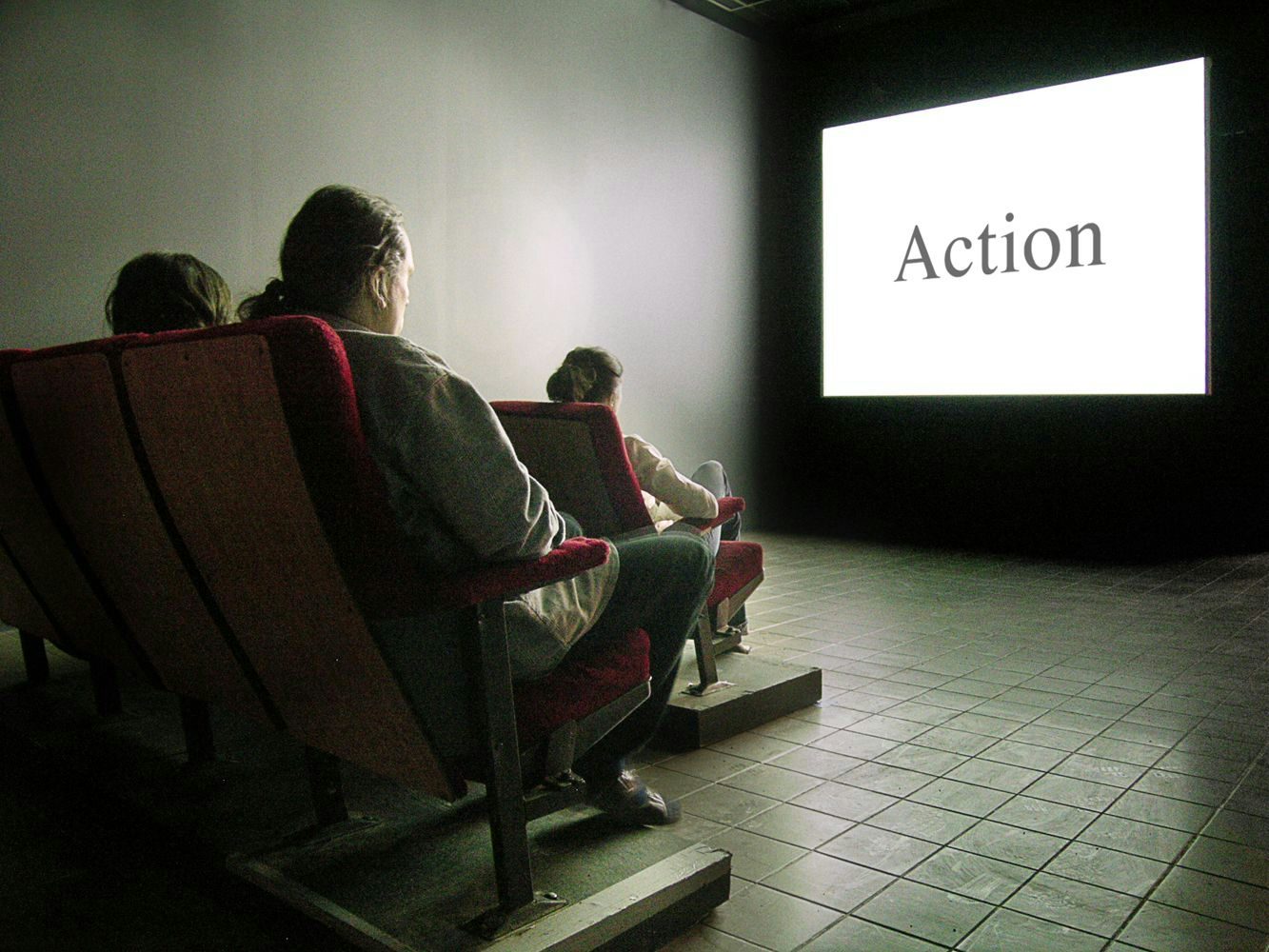
Nathalie Melikian
2005.01.08 - 02.12
OLIVIER ASSELIN
Contemporary art definitely has a great interest in the cinema. The so-called “visual” arts have, ever since the birth of the “seventh art”, undoubtedly always been interested in film, with, for example, the historical avant-gardes of the early twentieth century, and minimalism and conceptual art in the 1960s and 1970s. Over the past fifteen years, the cinema has once again become a privileged subject in the visual arts, as seen in the work of a number of artists – Jeff Wall, Stan Douglas, Geneviève Cadieux, Douglas Gordon, Mark Lewis, Matthew Barney, and more – and several exhibitions on the subject – from The Projected Image to Future Cinema and Hitchcock – to name only the most obvious examples. Within the visual arts, artists have been drawn to different facets of cinema: some have been attracted to the technological aspects of filming, others to issues of spectatorship and projection, and still others to the narrative forms of fiction film.
Nathalie Melikian’s work fits within this heightened interest in the cinema. It is both contemporary art and cinema: films and installations, film installations and installation films. Cinema is here inseparable from its mode of presentation – projected on widescreen – and reception – as a collective experience, at least potentially.

Action (1999), for example, is a film loop projected onto a giant screen in the gallery space. As its title indicates, it is an action film, an ordinary action film – with a hero, a heroine, bad guys, a central conflict, love, chase scenes, gun shots, killings, and so on, and a rich soundtrack.
But what is unique about this film is that it has no dialogue and, above all, no images. On the screen, title cards simply file past: words, sentences, paragraphs, black on a white background, separated by dissolves, generally at the same rhythm – like a silent film that overuses intertitles or a credit sequence that is too long (the procedure also recalls Michael Snow’s film So Is This).
These texts describe the film that we do not see: the story, location, protagonists, action, camera movements, editing, sound, music, etc. The texts describe all this, however, in an elliptical and very general manner. They are often incomplete and vague, even a single word or phrase: “Action,” “Scene,” “Hero, Tall and Handsome,” “Bad Ass Villain,” “Big Breasted Blonde Woman,” “Airport,” “Exterior City. Day,” “Bomb Ticking,” “Blood Bath,” “Endless Failed Escape Attempts,” “Dialogue,” “Close Up,” “Angle Shot,” “Circular Pan,” “Travelling Shot,” “Crane Down From High Angle,” “Frame,” “Cut To,” “Dissolve,” “Build Up,” “Actual Sound,” “Voice Over,” “Bridge Music,” and so on.
Because the film is replaced by its description, its images by text, there is little to see in these works. But they leave much to the imagination. The melodramatic words, sounds, and music, obviously produce many mental images. A method such as this reveals the role of the imagination in the cinematographic experience as a whole, which always fills in the gaps left by the image – the before, the after, the near, the far, the off-screen, the gloomy, the blurry, etc. It also reveals the importance of sound and music in the cinema, and in mainstream cinema in particular, where they have probably become the most effective ways of ensuring the audience’s immersion in the story, creating an emotional response, and facilitating our understanding and interpretation of the film.
Here, however, the method is essentially parodic in nature. The film is a kind of remake, an ironic and not unapologetic remake. The language used to describe this absent film calls to mind the often simplistic and always condensed style of the scripts of commercial films, which, in order to minimize the time it takes to read and interpret them, go straight to the heart of the matter. Shown like this in an art gallery setting, this language becomes rather comical.
In this work, the description is often so general that it seems to address less a specific film than a film genre; to get right to the point, the commercial action film. And in this way, the text often surreptitiously passes from the simplistic language of the industryto the critical meta-language of cinema studies, which analyses the prevailing forms of the genre: “Formula Film Making,” “Good Guys/Bad Guys,” “FX Scenes, Everyone Dies Except the Hero and His Girl,” “Melodrama,” “No One Will Shoot at the Hero While He Is Crying in Agony Over the Loss of His Friend. The Battle Will Resume as Soon as He Is Over His Grief and Gets Angry. The Hero Will Be Victorious Within 45 Seconds of Becoming Angry.” Sound effects, clichés, and conventional music reinforce this analytical dimension.
Melikian’s works thus share some features with scholarly criticism of mainstream cinema, which is essentially American. They contribute in their way to the study of that cinema’s narrative conventions and political ideology, particularly the ideology of militarism, genre stereotypes, and images of masculinity and femininity, which it is constantly extending.
Contemporary art’s interest in the cinema is thus often a critical interest. It works to reveal, analyse, deconstruct, and even denounce the forms and content of a kind of dominant cinema, sometimes for aesthetic or historical reasons, but especially for moral and political reasons. This critical interest is a sign, no doubt, of the importance of film studies within visual studies, within the range of disciplines studying the image, particularly art history and studio art. But it is a sign, above all, of the cinema’s popularity and influence today.
Why is contemporary art today interested more in cinema than in television, or the Internet for example, which are just as popular, influential, and problematic as the cinema, if not more?
It may be that beneath this critical interest in a dominant social form lies an emotional fascination with an art that leaves no one indifferent. From this perspective, what contemporary art reveals above all is the central role that cinema still plays in the collective imagination, in both “high” and “low” culture.
But why does the cinema fascinate us so much, the way no other art and no other image does? Why does it still fascinate us so much today?
It is normal for a kind of artistic expression to be interested in a new technology, for an art form to be interested in an emerging industry, if only to size up the competition threatening to replace it or limit its influence. And this is no doubt why visual art first became interested in the cinema. In the early twentieth century, the cinema quickly became a serious rival to all the image arts, and to all the other arts as well. Some artistic practices may have initially rejected the cinema, but many ended up trying to assimilate it by using its technology or imitating its content, forms, apparatus, or effects.
Today, however, other forms of spectacle and other images have appeared – more efficient, more entertaining, and also more profitable. And yet the visual arts, like many other arts, keep returning to the cinema. But they return in a different manner: no longer to drive out a fear of the future, but perhaps, on the contrary, through a kind of nostalgia. It is as if the cinematic image, more than any other image today, can reveal a truth that the din of electronic images renders inaudible. It is as if that image, which Benjamin said was going to help destroy the aura of the work of art, has become, through a singular reversal of history, the aura’s last refuge: the site of a real presence, of a sacred quality, if not of meaning.
Nathalie Melikian’s installations may well formulate a critique of a kind of cinema by condemning its images in an iconoclastic gesture; still, they succumb to the fascination of the most archaic qualities of the cinematic apparatus. These projections of light and sound in this darkened room invite us to immerse ourselves in the same way the magic lantern did before them – to our great delight.